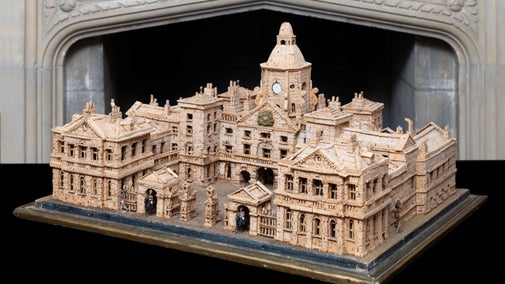
Petworth House and Park's collections
Explore the objects and works of art we care for at Petworth House and Park on the National Trust Collections website.

Petworth House showcases some of the finest collections in the National Trust, with major works by the likes of Titian, van Dyck, Reynolds and Blake on display. Inside you'll also find treasures such as the oldest English terrestrial globe in existence, alongside collections of silver and ceramics. There are over 9,000 items at Petworth, many of which you can see whilst visiting.
Many owners of Petworth House were collectors of fine art and these works remain on display here at Petworth as the centrepiece to your visit. The merging of art and interiors is what makes Petworth such a special place.
The paintings and sculptures here today are displayed in a similar way to when the 3rd Earl of Egremont (1751–1837) lived at Petworth, during a time that became known as Petworth's 'Golden Age'. During this period many artists, including painter JMW Turner, were invited to Petworth to take inspiration from the landscape and collections here.
The National Trust recently celebrated a Year of Treasures with the release of the book 125 Treasures. You can discover five of the featured artefacts at Petworth.
Please note some of the below items may not be on display during the winter as rooms are closed for conservation cleaning. Please check rooms open to view before travelling.


JMW Turner’s two paintings of Petworth Park: These paintings were commissioned by the 3rd Earl of Egremont as part of a set of four. You can see them in the Carved Room.
Ceramics collection: Petworth houses some of the finest ceramics in the National Trust. Both the 2nd and 3rd Earls of Egremont were keen collectors; look out for their treasures.
St Michael Triumphing over Satan by John Flaxman, North Gallery: This sculpture was commissioned by the 3rd Earl of Egremont and was inspired by John Milton’s Paradise Lost. The life-size group took nine years to complete and was Flaxman's last great work. Apart from the spear, it was carved from a single block of marble. The square bay of the North Gallery was designed specifically to display this work, where it can still be seen today.
During the winter months you may find that some of the rooms at Petworth are closed. This is so we can do vital conservation work to make sure that the collection items remain in the best possible condition.
It takes a team of conservation assistants five months to methodically clean, treat, record, cover, store and then return everything ready for reopening.
Other important work is carried out during this time, including moving and cleaning large pieces of furniture and polishing the floors.

Explore the objects and works of art we care for at Petworth House and Park on the National Trust Collections website.
From Tudor monarchs to romantic painters, discover the rich history of Petworth House and Park. Follow its journey from medieval home to grand and inspirational mansion.

From the medieval interiors of the chapel to the rooms of the historic kitchens, find out what you can see on a visit to the house at Petworth.

With plenty of space to run, jump and play there's lots to fun for families to have at Petworth.

See the breadth of our collection of works of art, furniture and more: we care for around a million objects at over 200 historic places, there’s a surprise discovery around every corner.

Discover the stories behind some of the greatest artworks and artefacts looked after by the National Trust, as told in a dedicated book, 125 Treasures from the Collections of the National Trust.

The art and heritage collections we care for rival the world’s greatest museums. Learn more about the collection of paintings, decorative art, costume, books, household and other objects at historic places.
